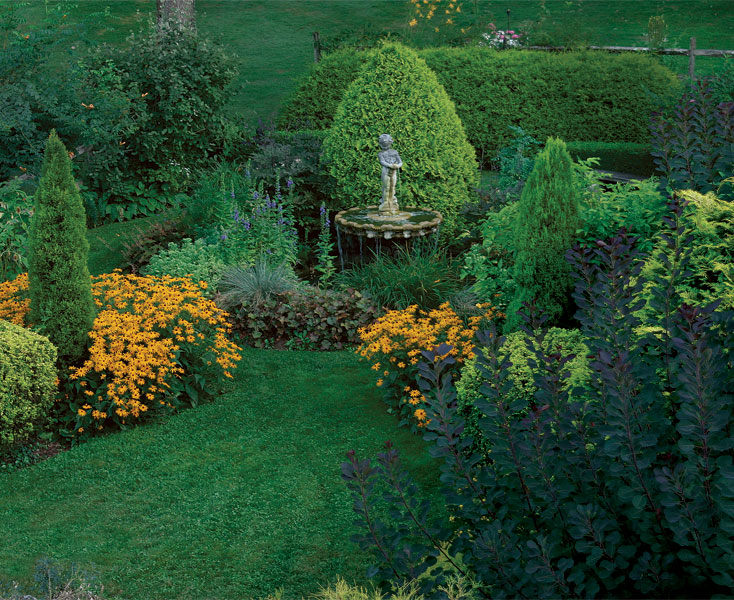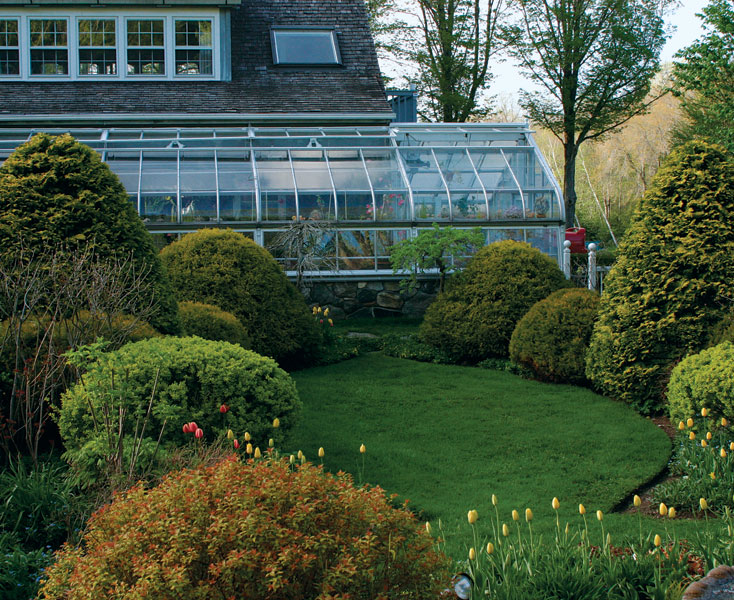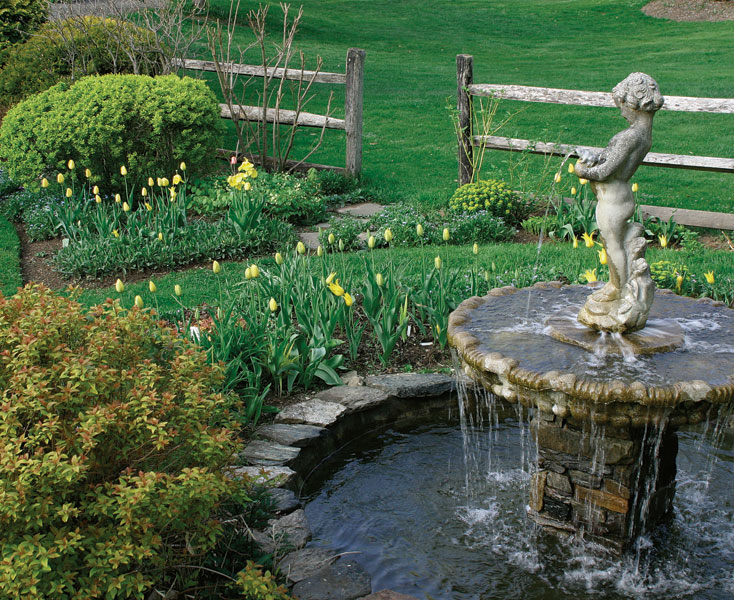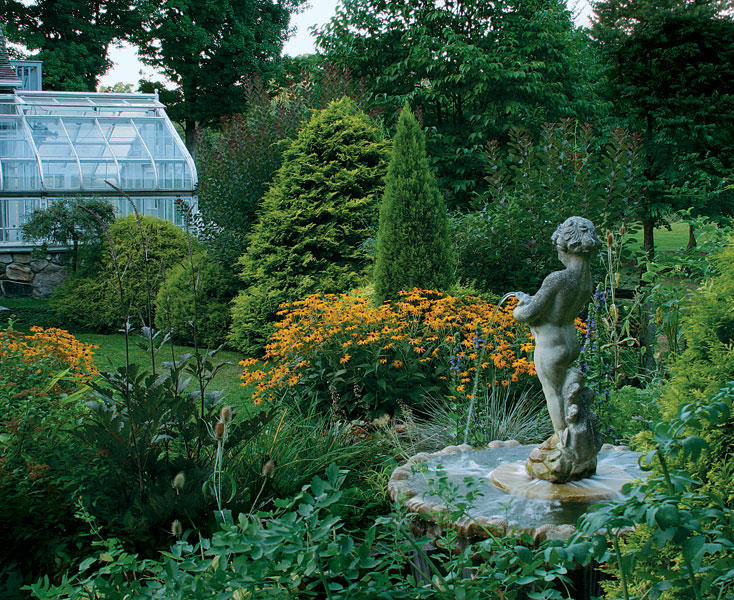Moon Shape Garden Plan Drawing
Design
Not Your Average Moon Garden
Bold shapes, a stiff pattern, and bright colors make this design stand out all day, every day

When nosotros built an addition to our 18th-century clapboard house and I looked out our new bedroom window, I recognized an opportunity to create a garden viewed from above that would offering cheer in every season and extend visual interest into the evening. It was a perfect spot for a moon garden: a garden of white flowers and foliage designed to be visible all evening. But because all good gardeners extract ideas from visits to great gardens and adapt them to their own mural, I am not afraid to acknowledge that I shamelessly stole the idea of using yellow-foliaged evergreens (or should they exist called "evergolds"?) for my "moon" garden from a visit to Crathes Castle in Scotland.
The extensive gardens there are all magnificent, merely I was captivated by one special infinite chosen the Gold Garden. As I entered this garden room surrounded by beautiful yellow and gilded conifers, I felt as if I had walked into warm sunshine right out of the gray Scottish mists. My farmhouse is no castle and our Connecticut climate is less than ideal, but this was a clear example where inspiration presented the perfect blueprint solution.
Virtually of the conifers with standout shapes and glowing foliage at Crathes Castle wouldn't survive our winters, so I selected hardy substitutes: species and cultivars that would brighten the scene well into the evening and warm the cold, dark season with a consistent backbone of glowing shrubs bundled in a distinctive programme.
A visible design extends the twenty-four hours

The area where I planned to build this garden allowed for a symmetrical pattern with aplenty space defined on one side by the straight stone wall of my rose garden. A dissever-runway argue runs at right angles from this wall, and a young oak tree stands near it, aligned with the end of our house. A new department of split-runway fence ties the oak tree to the corner of the house, creating a rectangle roughly 75 anxiety long and 30 feet wide.
I considered planting along the outer edges of this infinite, just I decided information technology would be more than interesting to carve up information technology into 2 singled-out areas to create the illusion of a larger space. A walk through intimate yet connected areas also adds the sense of journeying and drama that enhances an outdoor feel.

Photo/Illustration: Steven Cominsky
Because this garden would be viewed daily from my bedroom window, usually at dusk or dawn, I wanted to include a unique geometry recognizable from above and in low lite.
My friend, landscape architect Wallace Gray, inscribed a lovely figure eight inside the rectangular infinite. Rather than filling the figure with lawn surrounded by perimeter plantings, he suggested planting the two halves as opposites: the lesser half nearest the house every bit a central lawn surrounded by plantings, the other half equally a narrow grass path running around the edge of a central bed. With a fountain installed within the pinnacle half of the figure eight, the terminal grade consisted of an oval backyard at one end and a round outline of the fountain pool at the other.
I was confident that such a definitive design viewed from below or in a higher place would stand out at whatever hour and in every season.
A twist on tradition
Instead of sticking with the classic elements of a moon garden, I fabricated the follow adaptations to ensure my infinite was what I wanted.
White isn't ever right.
Silverish and white are the classic colors for a moon garden. Many white plants flower briefly, however, and are oftentimes less hardy than the gilt plants I have chosen. By shifting the main color of my garden to golden, I have greatly increased my plant palette with a full sequence of blooms and leaves from spring through fall.
A view exists from inside and out.
Moon gardens are traditionally places to sit and enjoy the transition from day to nighttime. I experience my moon garden from above, looking out my bedroom window, so the bold forms of my "evergolds" provide standout structure whenever I look down on this glowing outdoor room.
Sound can replace scent.
Many night-blooming plants common in moon gardens are wonderfully fragrant. Because evening scents are difficult to fully appreciate from my bedroom window, I've added the music of a small fountain as a layer of sensory interest.
Strong shrubs anchor the plan

I call this garden my "moon garden" because I virtually often view it by the light of the moon. Perhaps it should take been called the "sun garden" with its shades of chartreuse, yellow, and gold. When I awake in the morning, the gilt leaf evokes the sunday, a particularly pleasing effect during the nighttime days of winter.
Golden evergreens provide the backbone of this garden because they concord their foliage and form all year long. Ii tall, beautifully textured Hinoki cypress (Chamaecyparis obtusa 'Crippsii', USDA Hardiness Zones 4–8) anchor the oval lawn, flanked on either side by lower-growing arborvitae (Thuja occidentalis 'Rheingold', Zones 2–7), which plough a lovely bronze color in winter. A large, conical arborvitae (Thuja occidentalis 'Degroot'south Emerald Spire', Zones 2–7) highlights the fountain focal point. A hedge of aureate-thread sawara cypress (Chamaecyparis pisifera 'Filifera Aurea', Zones 4–8) forms a soft curve and enhances the intimacy of this garden room. 2 more sawaras announce the entrance to the garden with their striking, threadlike leafage.
Top adds interest to whatever garden past cartoon the centre up from the horizon, so each year, I transplant two columnar golden Monterey cypress (Cupressus macrocarpa 'Goldcrest', Zones 7–11) at the waist of the oval to punctuate its geometry. Fifty-fifty though they are not hardy in my climate, their contribution to the pattern is and so vital I don't begrudge digging them out each year to be overwintered indoors.

To add fifty-fifty more glowing colour, I utilise yellowish and gold perennials such as lily-flowered 'W Signal' tulips (Tulipa 'West Point', Zones 4–8), which sally in early spring effectually the fountain, and the strawberry-like flowers of waldsteinia (Waldsteinia ternata, Zones 3–8), which fill in below the shrubs in late spring. The ever-reliable 'Stella de Oro' daylily (Hemerocallis 'Stella de Oro', Zones 3–ten), which reblooms after jump, is joined past the golden blooms of blackness-eyed Susan (Rudbeckia fulgida var. sullivantii 'Goldsturm', Zones 4–9) as summer turns to autumn. I residuum all of these yellows with other colors—especially their complementary colour, purple—to create a vibrant scene throughout the season.
When visitors enter the moon garden at night, the borders polish brightly, extending the evening by an 60 minutes or more. Even in the depths of winter, the brilliant basic of my evergolds gleam. All-time of all, from my bedroom window, this garden graces my eyes every evening before I slip off to slumber and again in the morning time when I awake.
Get our latest tips, how-to articles, and instructional videos sent to your inbox.
The Latest
Podcast: Let'south Argue Nigh Plants
Episode 110: Best Gift Plants

Garden Photo of the Day
Spring in Northern Indiana

How-To
Growing Dark-green Mâche from Seed
-

How-To
Giving Back Through Gardening: Part ii
Source: https://www.finegardening.com/article/not-your-average-moon-garden

0 Response to "Moon Shape Garden Plan Drawing"
Post a Comment